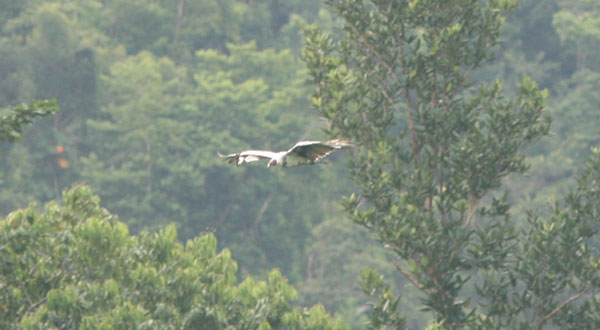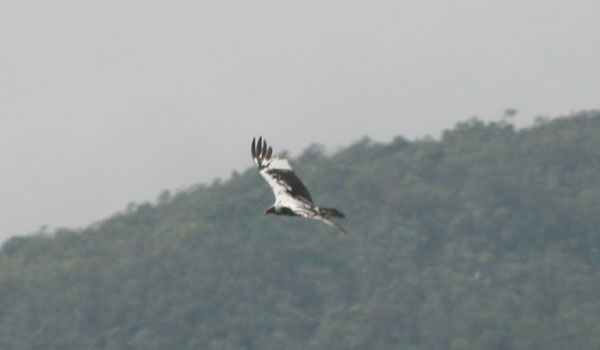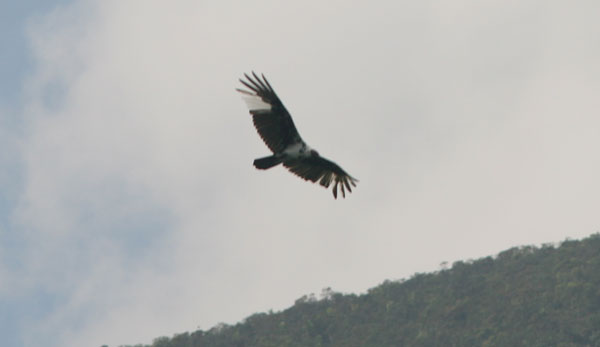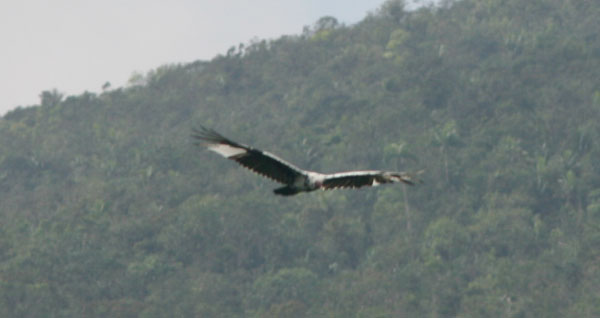Ecclesdown Road, a steep track that cuts through Jamaica’s lush John Crow Mountains, boasts some of the best birding in the country. On my visit there in the jolly company of John Fletcher, expert on island avifauna and president of BirdLife Jamaica, I beheld amazing endemics like Chestnut-bellied Cuckoo, Rufous-tailed Flycatcher, and both Yellow-billed and Black-billed Parrots. So why was the most memorable bird of my trip a Turkey Vulture?!?
In my defense, all I can say is, “What a turkey vulture!”
Individuals who live outside the regular range of Cathartes aura, which basically encompasses the New World, probably don’t understand the utter ubiquity of the bird. Sure, the TV is cool with its tippy, dihedral glide, roast beef-red visage, and ominous glare. But they are everywhere! If someone told me I’ve seen a million turkey vultures in my life, I wouldn’t be surprised. Here in New York, they compete mainly with Red-tailed Hawks for airspace but they even flourish in the lower latitudes where they have to complete with the equally burgeoning Black Vulture and a multiformity of raptors.
The turkey vulture may be just a step below Rock Pigeons in terms of the respect it usually commands from an American birder, but we were in a most auspicious location for this species. You see, the John Crow Mountains are actually named for the turkey vulture, known colloquially as John Crow. In fact, this association goes back even to when the area was called Carrion Crow Ridge. So there I was in the absolutely gorgeous tropical mountain chain named for the TV, watching many of them soar majestically, if not a bit erratically amidst flights of parrots. Then I spotted a vulture like none I’d ever seen before, bearing large expanses of white feathering against the usual dark plumage:

What a surprise it was to see this one unique individual in this most propitious place. I’ve never been so moved by a turkey vulture. In fact the bird made such an impression that I was still talking about the next day when Wayne Murdock of Attractions Link Ltd. took me to the Blue Mountains, home of world-class coffee and amazing birds. Wayne, a birder himself, knew exactly the bird I was so amazed by. In fact, he had a name for it: the Headman.

The Headman earned his name on account of his inimitable plumage, which evoked memories of the days of African-American slavery. According to Wayne, when a white slave-owner fathered a son with one of his slaves, he’d appoint the grown son to oversee the slaves. Apparently, the mixed heritage was supposed to inspire more merciful treatment. In any case, this partially leucistic turkey vulture was both black and white while the others were uniformly dark. The bird did seem to soar as if invested with a certain authority over its brethren so perhaps the title of Headman had gone to its (forgive me) head.

This very, very interesting tale became even more fascinating for me once I embarked on a little research in the Dictionary of Jamaican English By Frederic Gomes Cassidy. The Headman, I confirmed, is defined as the man in general charge of the laborers on an estate. What was more amazing was that this dictionary also has an entry for Headman John-Crow (also John-Crow Headman) which is “a white John Crow acknowledged as a leader by the black ones.” Such a bird may also be called King Crow, White Crow, or Parson. A footnote from 1943 attributed to Jeffery Smith suggests that cases of partial albinism were quite common.

So one has to wonder… how long has the Headman been ruling the John Crow Mountains? If you’re ever in the area, be sure to look him up!













Fascinating post, Mike. I’m a TV fan, as you know, and can imagine what an experience it was to see this one. When you add the historical and cultural references — wow! A case study of the ways birds can become totems and icons in human society.
Very cool. Maybe it has hybridized with a King Vulture? 🙂
Hi Mike! A very interesting article, made more so by the fact that some fellow birders and I saw what was, no doubt, the same bird on Ecclesdown Road. That was on 12/29/09. It is, indeed, a very striking bird. Oddly, there’s a similar partially albino TV that shows up on the Green Castle Estate, St. Mary Parish, a couple of hours away by car. I don’t think it’s the same bird, but haven’t been able to get a decent photo so far. Like you, I’ve seen many thousands of TVs in the New World, but this is my first encounter with partially albino vultures. Perhaps the Jamaican TVs have a genetic disposition towards albinism?
Hi Bob,
Thanks for sharing your own observations. Fascinating! Leucism must be in the vulture gene pool in Jamaica.
Did you know that whenever a headman john crow arrives at a feeding site,the other birds part and make way for him to get to the carcass and allow him to feed unmolested?
@Carlton – Is that really true? If so, that is absolutely fascinating. Thanks!
It interesting reading about albinism in the TV species. I was terrible disappointed when the writer uses anecdotes of a slavery-racial line to explain the existence of the TVs. As a boy growing up, I spent incalculable time admiring these majesticly, soaring birds. The ‘headman’ and ‘king bird’ monikers have no place in describing the avian interactions between the black TVs and their albino siblings.
Lawrence, I hope you didn’t get the impression I adopted a racist slant about this bird. If you read the full post, you’ll see that the Headman reference is part of Jamaican history. Not only was it explained to me when I first saw this amazing bird, but when I researched the term, I found references more than 70 years old.
No one that I know have ever seen a John Crows nest. Where do they nest?
Turkey vultures generally roost in trees but don’t build nests themselves. They may claim abandoned nests but often lay eggs in any out-of-the-way area.
Hello Mike,
I grew up in Kingston, Jamaica and I saw turkey vultures (Cathartes aura) – known to me as john crows just about every single day (1964 – 1981). As a child I did hear a fascinating story of the ‘John Crow Pastor’ – a special john crow that would come down and basically have a funeral sermon over the dead animal, then he would eat first and then the rest of the john crows would be allowed to eat. The bird was described to me by my grandfather who lived all his life in Jamaica (1901 -1983) and that the “John Crow Pastor’s” ‘robe’ was white. What foolishness they used to tell me (plus whole bunch of other stories that are just now making sense), I thought to myself as I grew older. It turns out that there is something to all the stories that my grandfather used to tell me. It seems that this “John Crow Pastor” or Parson John Crow could have been a King vulture (Sarcoramphus papa) – maybe a hybrid, but I doubt the albino theory as the behavior described sounds as if the turkey vultures had some fear of this other bird as it is always allowed to eat first. I’m not a biologist, have never even seen the behavior or the bird, but just fascinated by how history and folklore are pasted on from generation to generation. I could see how the headman reference could come across as offensive but that was how a lot of history was passed down to us. Things like slavery, rape and brutal oppression happened and many of our ancestors were never allowed to tell their history. On a personal note when someone referred to me as the “HNIC” at work and I reacted with an angry tone – in looking back my behavior was inappropriate for a work setting and I had to process and explore why I was so angry and ways to react so I keep my job. There is even a Jamaican saying “every john crow think him pickney white” – “everyone thinks that their child is special”. The deeper meaning as I look into that saying is that John Crows (by their behavior) value “whiteness” and think it’s special or better. Something that might have been beaten to our subconscious and we (the ancestors of the slaves) are still processing.
I grew up in Jamaica on a small farm and I can tell you the myth is true since I’ve seen it with my own eyes.
When something dies the black John crows would circle and perch in nearby trees but will not approve the carcass till the headman shows up and eat first. This is usually will bigger animals like goats or cows etc. after the headman has made his exit then it would be free for all.